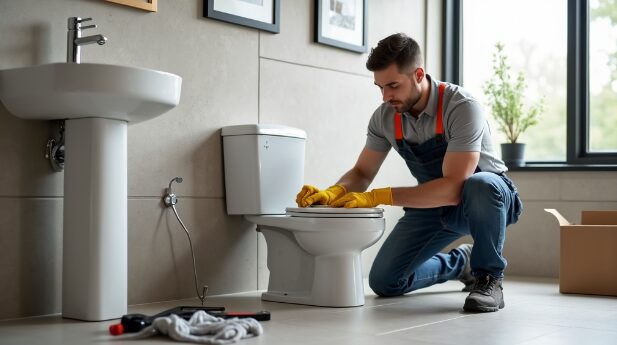Toilet replacement and installation is a task that many homeowners face at some point. A new toilet can improve your bathroom’s look and function. You might be thinking about how to replace an old one or install a new one. Here’s everything you need to know to get started.
Table of Contents
Key Takeaways
- Choose the right toilet: Different types fit different needs.
- Measure your space: Ensure that your new toilet fits well in your bathroom.
- Consider water use: Low-flow toilets save water and money.
- Get tools ready: You will need basic tools for the job.
- Hire a pro if unsure: If you’re not confident, it’s okay to ask for help.
For more detailed information on eco-friendly options, check out our page on Sustainable Bathroom Solutions.
Understanding the Types of Toilet Replacement and Installation
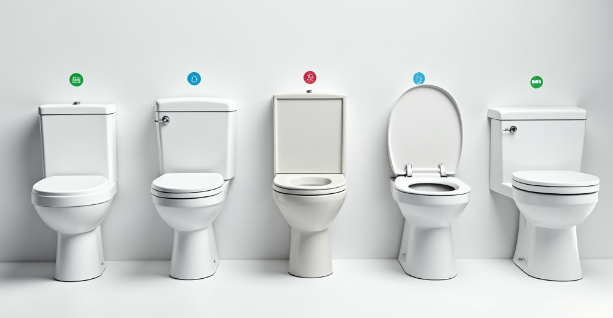
When you think about toilets, you might picture the classic design. However, there are many options. Here are some popular types:
1. Standard Toilets
These are the most common toilets found in homes. They have a tank at the back and are available in different heights and styles. They are easy to find and can suit most bathrooms.
2. Low-Flow Toilets
These toilets use less water per flush. They are a great choice for saving money on water bills. In Vancouver, many homes are moving towards low-flow options to help the environment.
3. Dual-Flush Toilets
These toilets have two buttons. One is for liquid waste and uses less water. The other is for solid waste. This design helps save even more water.
4. Wall-Mounted Toilets
These are installed onto the wall, leaving space on the floor. This style can give a sleek look and makes cleaning easier. However, they can be more expensive to install.
Why Toilet Replacement and Installation?
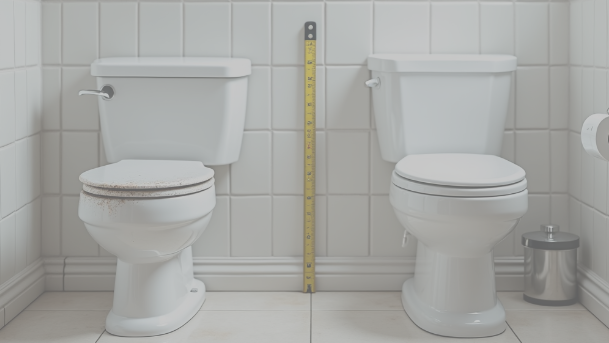
There are many reasons to replace an old toilet. Here are some common ones:
1. Water Efficiency
Older toilets can use a lot of water. Replacing them with newer models can cut your water use. This not only helps the environment but also lowers your water bill.
2. Comfort
Newer toilets often have better height options. Some are taller, making them easier to use for many people.
3. Design
A new toilet can update your bathroom’s look. If you’re remodeling, a modern toilet can be a great finishing touch. Additionally, a new toilet can also increase the overall functionality and efficiency of your bathroom. Many modern toilets have water-saving features, which can help lower your water bill and reduce your environmental impact. When updating your bathroom, it’s also worth considering the benefits of window replacement to improve natural lighting and ventilation.
4. Functionality
If your toilet often clogs or leaks, it may be time for a new one. A new toilet can save you from frequent repairs.
Measuring Your Space
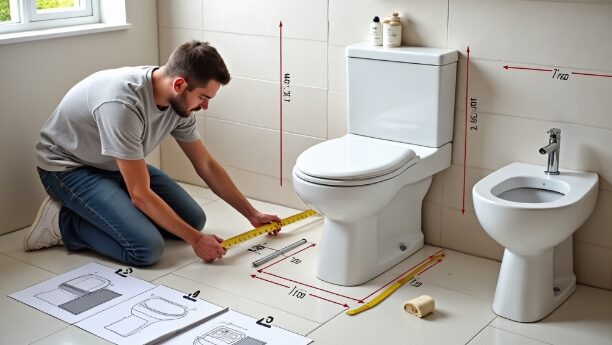
Before you buy a new toilet, measuring your bathroom is essential. Here’s how to do it:
1. Measure the Rough-In
The rough-in is the distance from the wall to the center of the drain pipe. In most homes, this is usually 12 inches, but it can be 10 or 14 inches in some cases. Make sure to check this before purchasing a new toilet.
2. Check Height and Width
Toilets come in different heights. Standard heights are about 15 inches, while comfort heights are around 17 to 19 inches. Choose a height that suits your needs. Also, measure the width of the space to make sure the new toilet fits.
3. Consider the Floor Type
If you have tile or linoleum, consider how the new toilet will look with your flooring. A new toilet can change the feel of your bathroom.
Additional Space Considerations
| Measurement Type | Recommended Value | Description |
|---|---|---|
| Rough-In Height | 10″, 12″, or 14″ | Distance from wall to drain pipe center |
| Toilet Height | 15″-19″ | Standard vs. comfort height options |
| Width Space | 24″ or more | Minimum width for comfortable use |
Selecting the Right Toilet
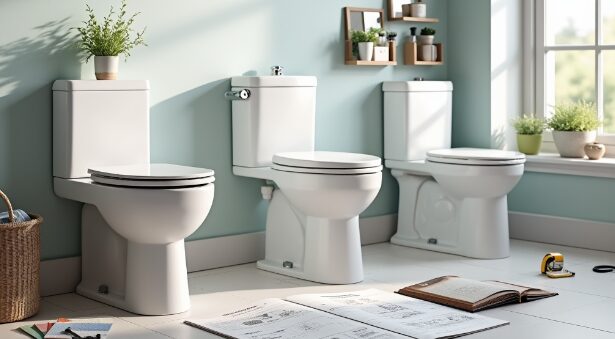
Now that you know what types there are and how to measure your space, it’s time to choose the right toilet. Here are some tips:
1. Budget
Toilets can vary widely in price. Set a budget before you start shopping. This will help you narrow down your options.
2. Style
Look for a style that fits your bathroom. You can choose from traditional, modern, or sleek designs. Think about how it will match your current decor.
3. Features
Some toilets come with extra features like heated seats or self-cleaning options. Decide which features matter most to you.
4. Reviews and Recommendations
- Research online reviews for different toilet models.
- Ask friends or family about their experiences with specific brands.
- Check for any consumer reports on toilet performance.
Tools You’ll Need
If you’re planning to install the toilet yourself, gather these tools:
1. Wrench
You will need a wrench to remove the old toilet. A socket wrench can also work.
2. Screwdriver
A screwdriver will help you tighten bolts and screws.
3. Plumber’s Tape
This tape can help seal connections and prevent leaks.
4. Level
A level ensures your new toilet sits flat on the floor.
5. Bucket and Sponge
Have these on hand to catch any water during the removal process.
Steps to Toilet Replacement and Installation
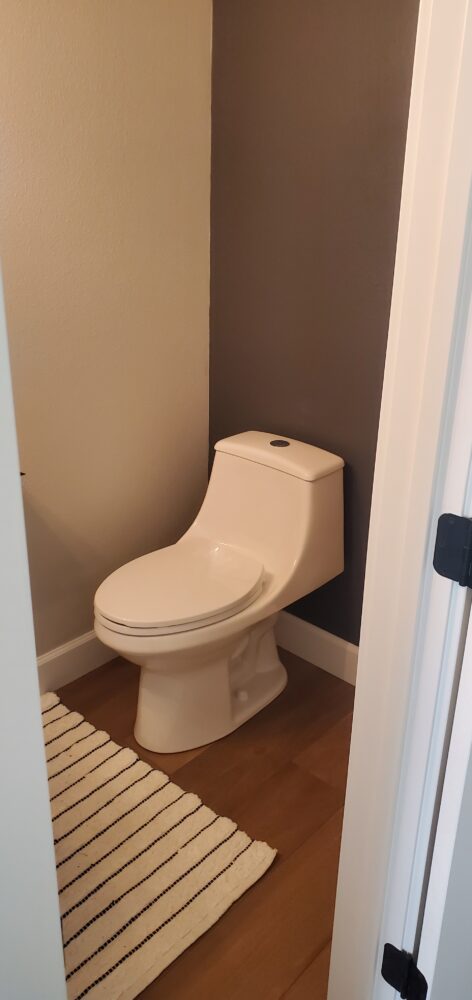
Replacing a toilet may seem daunting. Here’s a step-by-step guide to help you through the process.
1. Turn Off the Water
Locate the shut-off valve behind the toilet and turn it off. This stops the water flow.
2. Empty the Toilet
Flush the toilet to empty the tank and bowl. Use a sponge or towel to soak up any remaining water.
3. Remove the Old Toilet
Use your wrench to unbolt the toilet from the floor. Carefully lift the toilet off the flange and set it aside. Be careful as it can be heavy.
4. Prepare the Flange
Check the flange for damage. If it’s cracked, you may need to replace it. Make sure it’s clean and ready for the new toilet.
5. Install New Wax Ring
Put a new wax ring on the flange. This ring creates a seal between the toilet and the drain.
6. Place the New Toilet
Lift the new toilet over the flange and carefully lower it onto the wax ring. Make sure it sits straight.
7. Bolt It Down
Use the wrench to tighten the bolts, securing the toilet to the floor. Be careful not to overtighten, as this can crack the toilet.
8. Connect the Water Supply
Reattach the water line to the toilet and turn on the shut-off valve. Let the tank fill and check for leaks.
9. Test the Toilet
Flush the toilet a few times to make sure it works correctly. Check around the base for any leaks.
Hiring a Professional
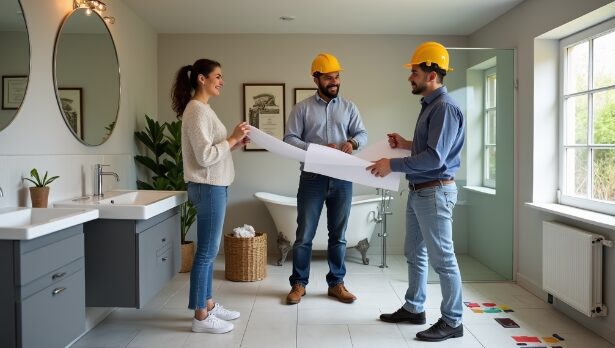
If you feel overwhelmed, hiring a professional can be a good choice. Here are some reasons to consider it:
1. Experience
Professionals know how to handle problems like leaks and uneven floors. They can work quickly and efficiently.
2. Tools
Contractors come with all the tools needed for the job. You won’t have to worry about buying or borrowing tools.
3. Warranty
Some contractors offer warranties on their work. This can give you peace of mind.
Consider consulting with our team at Prestige Construction & Home Remodeling for professional installation services.
Finding a Reliable Contractor in Vancouver
If you decide to hire someone, here’s how to find a good contractor in Vancouver:
1. Check Reviews
Look online for reviews from other customers. This can give you an idea of their work quality.
2. Ask for Recommendations
Talk to friends or family who have recently done similar work. They may have someone they trust.
3. Verify Licenses
Make sure the contractor has the necessary licenses and insurance. This protects you in case of accidents or issues.
The Importance of Maintenance
After installing your new toilet, maintenance is key. Here are some tips to keep it in good shape:
1. Regular Cleaning
Keep your toilet clean to prevent stains and odors. Use a toilet cleaner and brush regularly.
2. Check for Leaks
Periodically check the water supply line and the base of the toilet for leaks. If you notice any water, address it right away.
3. Mind the Flush
If the toilet starts to flush poorly, this may mean there’s a problem. Check for clogs or issues with the flapper valve.
Common Maintenance Checklist
| Maintenance Task | Frequency | Notes |
|---|---|---|
| Clean Toilet Bowl | Weekly | Use appropriate toilet cleaner |
| Inspect Water Supply Line | Monthly | Look for leaks or wear |
| Test Flush Mechanism | Every 6 months | Check for proper functioning |
Common Problems and Solutions
Even new toilets can have issues. Here are some common ones you might encounter:
1. Running Toilet
If your toilet keeps running, it might be the flapper. Replacing it can solve the problem.
2. Clogs
If the toilet clogs often, it may not be the right toilet for you. Consider a model designed for better flushing.
3. Cracked Tank
If you notice cracks, stop using the toilet immediately. A cracked tank can leak and cause water damage.
Conclusion
Replacing and installing a toilet doesn’t have to be scary. With the right information and tools, you can do it yourself or find a reliable contractor. Remember to measure your space, choose the right toilet, and consider hiring a professional if needed. A new toilet can make your bathroom more comfortable and stylish.
If you’re ready to get started, contact us at Prestige Construction & Home Remodeling. We can help you find the best toilet for your home and ensure a smooth installation.
By following these tips, you can make your toilet replacement and installation experience as easy as possible. Whether you’re a DIY enthusiast or prefer to hire a pro, having the right information is key.

